Optimal Selection of Empirical Reference Evapotranspiration Method in 36 Different Agricultural Zones of China
Abstract
:1. Introduction
2. Materials and Methods
2.1. Study Area
2.2. Data Collection
2.3. Selected ET0 Methods
2.4. Calibration Method
2.5. Evaluation Criteria and Statistical Analysis
3. Results
3.1. ET0 Values Calculated Using the FAO56-PM and Empirical Methods
3.2. Statistical Criteria of Temperature-Based Methods
3.3. Statistical Criteria of Radiation-Based Methods
3.4. Recommended Empirical Methods in Different Agricultural Zones
3.5. Calibration of the Empirical Methods in Different Agricultural Zones
4. Discussion
4.1. Comparison with Previous Studies
4.2. Selection of Reliable Empirical Methods Based on Climatic Conditions
5. Conclusions
Supplementary Materials
Author Contributions
Funding
Institutional Review Board Statement
Informed Consent Statement
Data Availability Statement
Conflicts of Interest
References
- Jung, M.; Reichstein, M.; Ciais, P.; Seneviratne, S.I.; Sheffield, J.; Goulden, M.L.; Bonan, G.; Cescatti, A.; Chen, J.; de Jeu, R.; et al. Recent decline in the global land evapotranspiration trend due to limited moisture supply. Nature 2010, 467, 951–954. [Google Scholar] [CrossRef] [PubMed]
- Xiang, K.; Li, Y.; Horton, R.; Feng, H. Similarity and difference of potential evapotranspiration and reference crop evapotranspiration—A review. Agric. Water Manag. 2020, 232, 106043. [Google Scholar] [CrossRef]
- Fan, J.; Yue, W.; Wu, L.; Zhang, F.; Cai, H.; Wang, X.; Lu, X.; Xiang, Y. Evaluation of SVM, ELM and four tree-based ensemble models for predicting daily reference evapotranspiration using limited meteorological data in different climates of China. Agric. For. Meteorol. 2018, 263, 225–241. [Google Scholar] [CrossRef]
- Kim, D.; Chun, J.A.; Ko, J. A hybrid approach combining the FAO-56 method and the complementary principle for predicting daily evapotranspiration on a rainfed crop field. J. Hydrol. 2019, 577, 123941. [Google Scholar] [CrossRef]
- McMahon, T.A.; Finlayson, B.L.; Peel, M.C. Historical developments of models for estimating evaporation using standard meteorological data. Wires Water 2016, 3, 788–818. [Google Scholar] [CrossRef]
- De Bruin, H.A.R.; Trigo, I.F.; Bosveld, F.C.; Meirink, J.F. A thermodynamically based model for actual evapotranspiration of an extensive grass field close to FAO reference, suitable for remote sensing application. J. Hydrometeorol. 2016, 17, 1373–1382. [Google Scholar] [CrossRef]
- Wang, J.; Wang, J.L.; Zhao, C.X.; McGiffen, M.E.; Liu, J.B.; Wang, G.D. Assessing the performance of two models on calculating maize actual evapotranspiration in a semi-humid and drought-prone region of China. Theor. Appl. Climatol. 2018, 131, 1147–1156. [Google Scholar] [CrossRef]
- Martel, M.; Glenn, A.; Wilson, H.; Kröbel, R. Simulation of actual evapotranspiration from agricultural landscapes in the Canadian Prairies. J. Hydrol. Reg. Stud. 2018, 15, 105–118. [Google Scholar] [CrossRef]
- Allen, R.G.; Pereira, L.S.; Raes, D.; Smith, M. Crop Evapotranspiration—Guidelines for Computing Crop Water Requirements; FAO Irrigation and Drainage Paper No. 56; FAO: Rome, Italy, 1998. [Google Scholar]
- Kisi, O.; Alizamir, M. Modelling reference evapotranspiration using a new wavelet conjunction heuristic method: Wavelet extreme learning machine vs wavelet neural networks. Agric. For. Meteorol. 2018, 263, 41–48. [Google Scholar] [CrossRef]
- Martí, P.; Zarzo, M. Multivariate statistical monitoring of ETo: A new approach for estimation in nearby locations using geographical inputs. Agric. For. Meteorol. 2012, 152, 125–134. [Google Scholar] [CrossRef]
- Xu, S.; Yu, Z.; Yang, C.; Ji, X.; Zhang, K. Trends in evapotranspiration and their responses to climate change and vegetation greening over the upper reaches of the Yellow River Basin. Agric. For. Meteorol. 2018, 263, 118–129. [Google Scholar] [CrossRef]
- Lu, Y.; Cai, H.; Jiang, T.; Sun, S.; Wang, Y.; Zhao, J.; Yu, X.; Sun, J. Assessment of global drought propensity and its impacts on agricultural water use in future climate scenarios. Agric. For. Meteorol. 2019, 278, 107623. [Google Scholar] [CrossRef]
- Doorenbos, J.; Pruitt, W.O. Guidelines for Predicting Crop Water Requirements, 2nd ed.; FAO Irrigation and Drainage Paper No. 24; FAO: Roma, Italy, 1977. [Google Scholar]
- Ahmadi, S.H.; Javanbakht, Z. Assessing the physical and empirical reference evapotranspiration (ETo) models and time series analyses of the influencing weather variables on ETo in a semi-arid area. J. Environ. Manag. 2020, 276, 111278. [Google Scholar] [CrossRef]
- Pereira, L.S.; Allen, R.G.; Smith, M.; Raes, D. Crop evapotranspiration estimation with FAO56: Past and future. Agric. Water Manag. 2015, 147, 4–20. [Google Scholar] [CrossRef]
- Shiri, J. Evaluation of FAO56-PM, empirical, semi-empirical and gene expression programming approaches for estimating daily reference evapotranspiration in hyper-arid regions of Iran. Agric. Water Manag. 2017, 188, 101–114. [Google Scholar] [CrossRef]
- Kashyap, P.S.; Panda, R.K. Evaluation of evapotranspiration estimation methods and development of crop-coefficients for potato crop in a sub-humid region. Agric. Water Manag. 2001, 50, 9–25. [Google Scholar] [CrossRef]
- Liu, X.; Xu, C.; Zhong, X.; Li, Y.; Yuan, X.; Cao, J. Comparison of 16 models for reference crop evapotranspiration against weighing lysimeter measurement. Agric. Water Manag. 2017, 184, 145–155. [Google Scholar] [CrossRef]
- Bourletsikas, A.; Argyrokastritis, I.; Proutsos, N. Comparative evaluation of 24 reference evapotranspiration equations applied on an evergreen-broadleaved forest. Hydrol. Res. 2018, 49, 1028–1041. [Google Scholar] [CrossRef]
- Awal, R.; Habibi, H.; Fares, A.; Deb, S. Estimating reference crop evapotranspiration under limited climate data in West Texas. J. Hydrol. Reg. Stud. 2020, 28, 100677. [Google Scholar] [CrossRef]
- Moratiel, R.; Bravo, R.; Saa, A.; Tarquis, A.M.; Almorox, J. Estimation of evapotranspiration by the Food and Agricultural Organization of the United Nations (FAO) Penman-Monteith temperature (PMT) and Hargreaves-Samani (HS) models under temporal and spatial criteria—A case study in Duero basin (Spain). Nat. Hazards Earth Syst. Sci. 2020, 20, 859–875. [Google Scholar] [CrossRef] [Green Version]
- Aschonitis, V.G.; Papamichail, D.; Demertzi, K.; Colombani, N.; Mastrocicco, M.; Ghirardini, A.; Castaldelli, G.; Fano, E. High-resolution global grids of revised Priestley-Taylor and Hargreaves-Samani coefficients for assessing ASCE-standardized reference crop evapotranspiration and solar radiation. Earth Syst. Sci. Data 2017, 9, 615–638. [Google Scholar] [CrossRef] [Green Version]
- Valle, L.C.G., Jr.; Ventura, T.M.; Gomes, R.S.R.; de S. Nogueira, J.; de A. Lobo, F.; Vourlitis, G.L.; Rodrigues, T.R. Comparative assessment of modelled and empirical reference evapotranspiration methods for a brazilian savanna. Agric. Water Manag. 2020, 232, 106040. [Google Scholar] [CrossRef]
- Pandey, P.K.; Dabral, P.P.; Pandey, V. Evaluation of reference evapotranspiration methods for the northeastern region of India. Int. Soil Water Conserv. Res. 2016, 4, 52–63. [Google Scholar] [CrossRef] [Green Version]
- Tabari, H.; Grismer, M.E.; Trajkovic, S. Comparative analysis of 31 reference evapotranspiration methods under humid conditions. Irrig. Sci. 2013, 31, 107–117. [Google Scholar] [CrossRef]
- Samaras, D.A.; Reif, A.; Theodoropoulos, K. Evaluation of radiation-based reference evapotranspiration models under different mediterranean climates in central Greece. Water Resour. Manag. 2013, 28, 207–225. [Google Scholar] [CrossRef]
- Quej, V.H.; Almorox, J.; Arnaldo, J.A.; Moratiel, R. Evaluation of temperature-based methods for the estimation of reference evapotranspiration in the Yucatán Peninsula, Mexico. J. Hydrol. Eng. 2019, 4, 5018029. [Google Scholar] [CrossRef]
- Xystrakis, F.; Matzarakis, A. Evaluation of 13 empirical reference potential evapotranspiration equations on the island of Crete in Southern Greece. J. Irrig. Drain. Eng. 2011, 137, 211–222. [Google Scholar] [CrossRef] [Green Version]
- Salam, R.; Islam, A.; Pham, Q.B.; Dehghani, M.; Al-Ansari, N.; Linh, N.T.T. The optimal alternative for quantifying reference evapotranspiration in climatic sub-regions of Bangladesh. Sci. Rep. 2020, 10, 20171. [Google Scholar] [CrossRef]
- Jensen, M.E.; Allen, R.G. Evaporation, Evapotranspiration, and Irrigation Water Requirements. In ASCE Manuals and Reports on Engineering Practices No. 70; ASCE: New York, NY, USA, 2016. [Google Scholar]
- Xu, J.; Peng, S.; Ding, J.; Wei, Q.; Yu, Y. Evaluation and calibration of simple methods for daily reference evapotranspiration estimation in humid East China. Arch. Agron. Soil Sci. 2013, 59, 845–858. [Google Scholar] [CrossRef]
- Gao, F.; Feng, G.; Ouyang, Y.; Wang, H.; Fisher, D.; Adeli, A.; Jenkins, J. Evaluation of reference evapotranspiration methods in arid, semiarid, and humid regions. J. Am. Water Resour. Assoc. 2017, 53, 791–808. [Google Scholar] [CrossRef]
- Gong, X.; Wang, S.; Xu, C.; Zhang, H.; Ge, J. Evaluation of Several reference evapotranspiration models and determination of crop water requirement for tomato in a solar greenhouse. HortScience 2020, 55, 244–250. [Google Scholar] [CrossRef] [Green Version]
- Li, M.; Chu, R.; Islam, A.; Shen, S. Reference evapotranspiration variation analysis and its approaches evaluation of 13 empirical models in sub-humid and humid regions: A case study of the Huai River basin, Eastern China. Water 2018, 10, 493. [Google Scholar] [CrossRef] [Green Version]
- Celestin, S.; Qi, F.; Li, R.; Yu, T.; Cheng, W. Evaluation of 32 simple equations against the Penman-Monteith method to estimate the reference evapotranspiration in the Hexi Corridor, Northwest China. Water 2020, 12, 2772. [Google Scholar] [CrossRef]
- Zhao, S.; Yang, Y.; Zhang, F.; Sui, X.; Yao, Y.; Zhao, N.; Zhao, Q.; Li, C. Rapid evaluation of reference evapotranspiration in Northern China. Arab. J. Geosci. 2015, 8, 647–657. [Google Scholar] [CrossRef]
- Peng, L.; Li, Y.; Feng, H. The best alternative for estimating reference crop evapotranspiration in different sub-regions of mainland China. Sci. Rep. 2017, 7, 5458. [Google Scholar] [CrossRef] [Green Version]
- Yang, Y.; Luo, Y.; Wu, C.; Zheng, H.; Zhang, L.; Cui, Y.; Sun, N.; Wang, L. Evaluation of six equations for daily reference evapotranspiration estimating using public weather forecast message for different climate regions across China. Agric. Water Manag. 2019, 222, 386–399. [Google Scholar] [CrossRef]
- Fan, J.; Wu, L.; Zhang, F.; Xiang, Y.; Zheng, J. Climate change effects on reference crop evapotranspiration across different climatic zones of China during 1956–2015. J. Hydrol. 2016, 542, 923–937. [Google Scholar] [CrossRef]
- Song, X.; Lu, F.; Xiao, W.; Zhu, K.; Zhou, Y.; Xie, Z. Performance of 12 reference evapotranspiration estimation methods compared with the Penman-Monteith method and the potential influences in northeast China. Meteorol. Appl. 2019, 26, 83–96. [Google Scholar] [CrossRef] [Green Version]
- UNEP. World Atlas of Desertification. In World Atlas of Desertification; Middleton, N.J., Thomas, D.S.G., Eds.; Arnold: London, UK, 1997. [Google Scholar]
- Allen, R.G.; Pruitt, W.O. FAO-24 reference evapotranspiration factors. J. Irrig. Drain. Eng. 1991, 117, 758–773. [Google Scholar] [CrossRef]
- Hargreaves, G.H.; Samani, Z.A. Reference crop evapotranspiration from temperature. Appl. Eng. Agric. 1985, 1, 96–99. [Google Scholar] [CrossRef]
- Valiantzas, J.D. Simplified forms for the standardized FAO-56 Penman-Monteith reference evapotranspiration using limited weather data. J. Hydrol. 2013, 505, 13–23. [Google Scholar] [CrossRef]
- Irmak, S.; Irmak, A.; Allen, R.G.; Jones, A.W. Solar and net radiation-based equations to estimate reference evapotranspiration in humid climates. J. Irrig. Drain. Eng. 2003, 129, 336–347. [Google Scholar] [CrossRef]
- Valiantzas, J.D. Simple ET0 forms of Penman’s equation without wind and/or humidity data. II: Comparisons with reduced set-FAO and other methodologies. J. Irrig. Drain. Eng. 2013, 139, 9–19. [Google Scholar] [CrossRef] [Green Version]
- Rahimikhoob, A.; Behbahani, M.R.; Fakheri, J. An evaluation of four reference evapotranspiration models in a subtropical climate. Water Resour. Manag. 2012, 26, 2867–2881. [Google Scholar] [CrossRef]
- Ngongondo, C.; Xu, C.-Y.; Tallaksen, L.M.; Alemaw, B. Evaluation of the FAO Penman-Montheith, Priestley-Taylor and Hargreaves models for estimating reference evapotranspiration in southern Malawi. Hydrol. Res. 2013, 44, 706–722. [Google Scholar] [CrossRef]
- Islam, S.; Alam, A.R. Performance evaluation of FAO Penman-Monteith and best alternative models for estimating reference evapotranspiration in Bangladesh. Heliyon 2021, 7, e07487. [Google Scholar] [CrossRef]
- Da Silva, R.D.; de Silva, M.A.; Canteri, M.G.; Rosisca, J.R.; Vieira Junior, N.A. Reference evapotranspiration for Londrina, Paraná, Brazil: Performance of different estimation methods. Semina Ciências Agrárias 2017, 38, 2363–2374. [Google Scholar] [CrossRef] [Green Version]
- Mallikarjuna, P.; Jyothy, S.A.; Murthy, D.S.; Reddy, K.C. Performance of Recalibrated equations for the estimation of daily reference evapotranspiration. Water Resour. Manag. 2014, 28, 4513–4535. [Google Scholar] [CrossRef]
- Issaka, A.I.; Paek, J.; Abdella, K.; Pollanen, M.; Huda, A.K.S.; Kaitibie, S.; Goktepe, I.; Haq, M.M.; Moustafa, A.T. Analysis and calibration of empirical relationships for estimating evapotranspiration in Qatar: Case study. J. Irrig. Drain. Eng. 2017, 143, 5016013. [Google Scholar] [CrossRef]
- Nouri, M.; Homaee, M. On modeling reference crop evapotranspiration under lack of reliable data over Iran. J. Hydrol. 2018, 566, 705–718. [Google Scholar] [CrossRef]
- Zhu, X.; Luo, T.; Luo, Y.; Yang, Y.; Guo, L.; Luo, H.; Fang, C.; Cui, Y. Calibration and validation of the Hargreaves-Samani model for reference evapotranspiration estimation in China. Irrig. Drain. 2019, 68, 822–836. [Google Scholar] [CrossRef]
- Gentilucci, M.; Bufalini, M.; Materazzi, M.; Barbieri, M.; Aringoli, D.; Farabollini, P.; Pambianchi, G. Calculation of potential evapotranspiration and calibration of the hargreaves equation using geostatistical methods over the last 10 years in central Italy. Geosciences 2021, 11, 348. [Google Scholar] [CrossRef]
- Kra, E. FAO-56 Penman-Monteith daily ET0 from linear regression calibrated Hargreaves equation with wind terms in tropics with limited data. Int. J. Agron. 2014, 2014, 402809. [Google Scholar] [CrossRef] [Green Version]
- Morales-Salinas, L.; Ortega-Farías, S.; Riveros-Burgos, C.; Neira-Román, J.; Carrasco-Benavides, M.; López-Olivari, R. Monthly calibration of Hargreaves-Samani equation using remote sensing and topoclimatology in central-southern Chile. Int. J. Remote Sens. 2017, 38, 7497–7513. [Google Scholar] [CrossRef]
- Sahoo, B.; Walling, I.; Deka, B.C.; Bhatt, B.P. Standardization of reference evapotranspiration models for a subhumid valley rangeland in the eastern Himalayas. J. Irrig. Drain. Eng. 2012, 138, 880–895. [Google Scholar] [CrossRef]
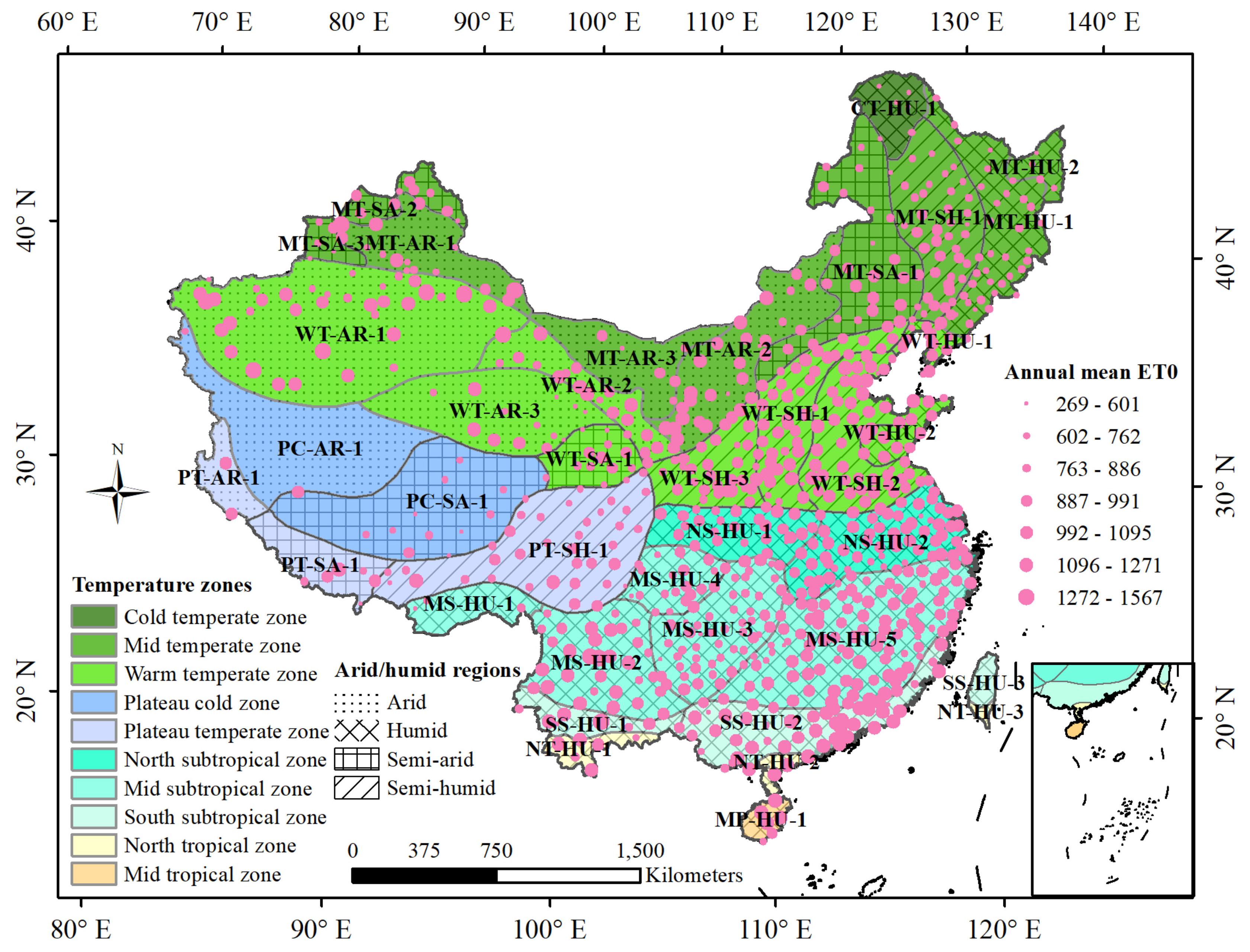
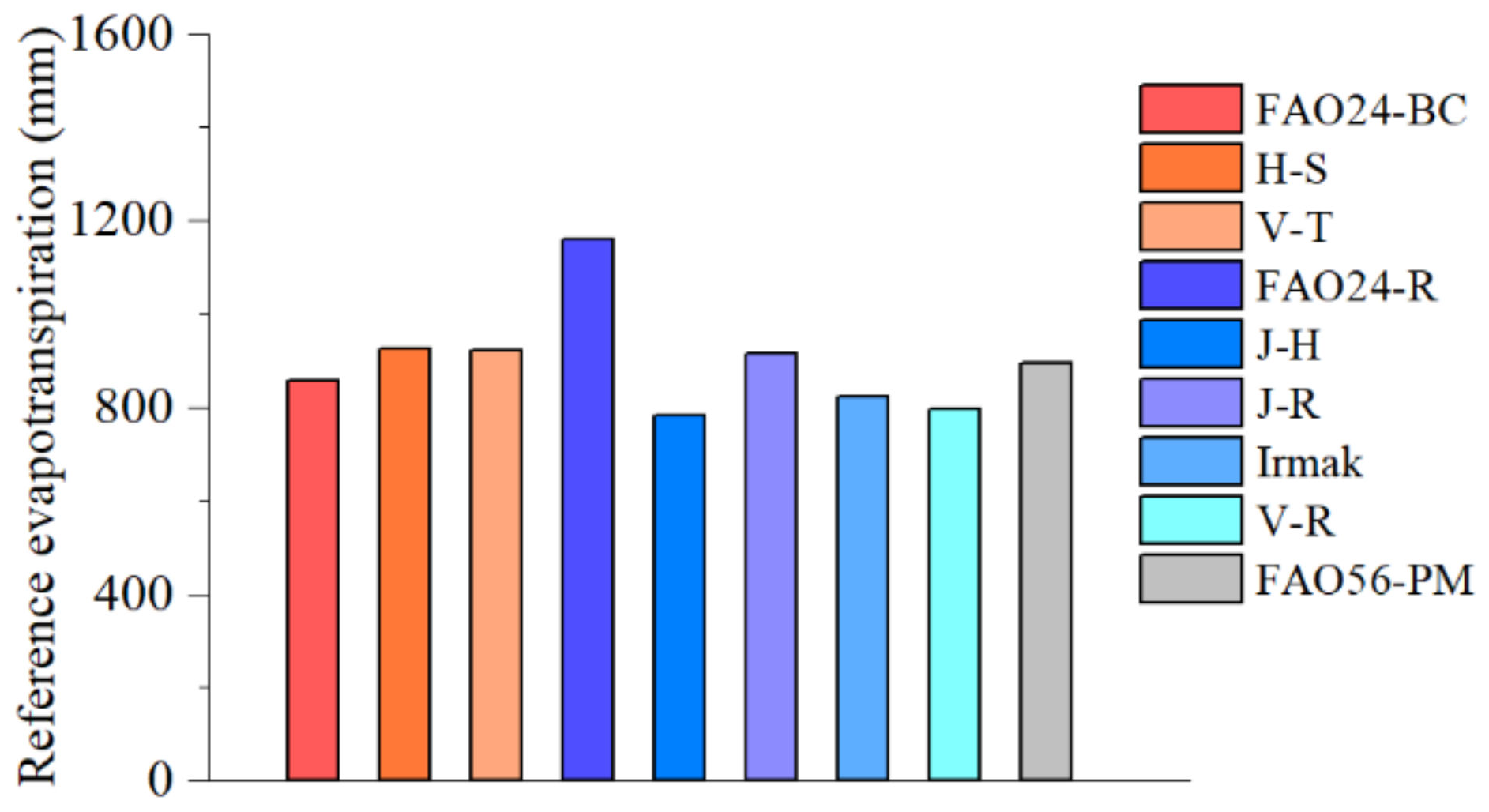
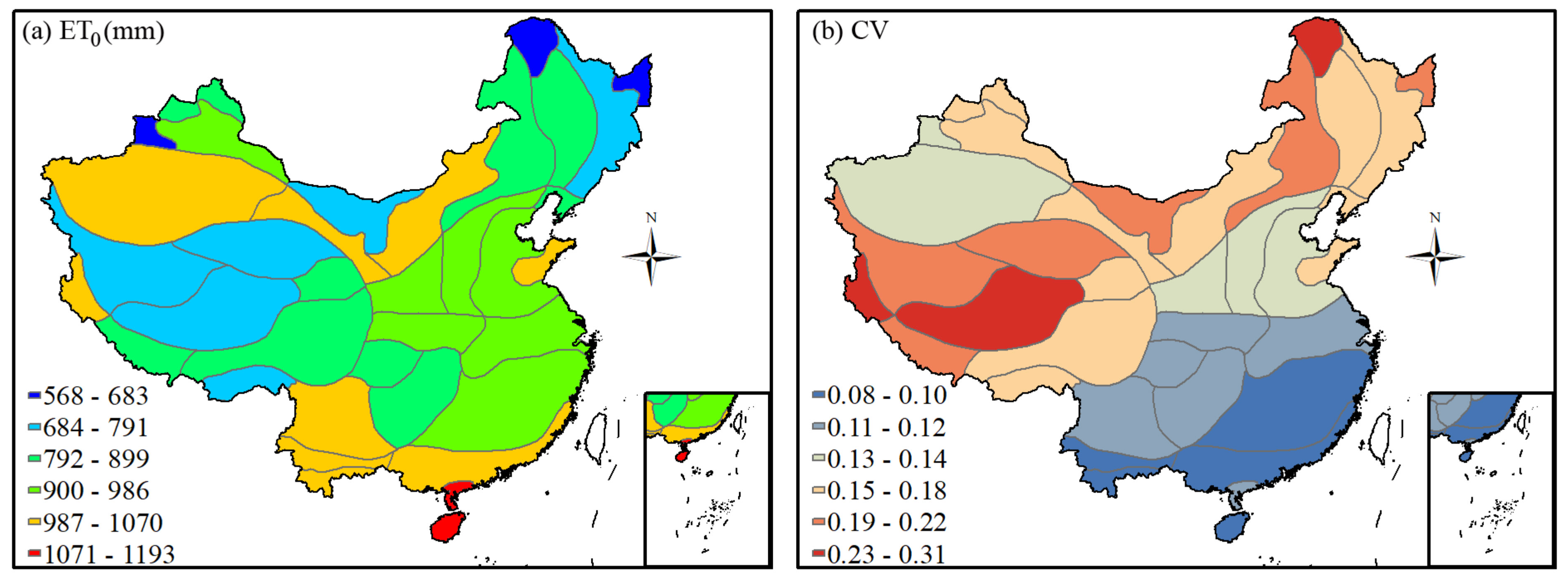
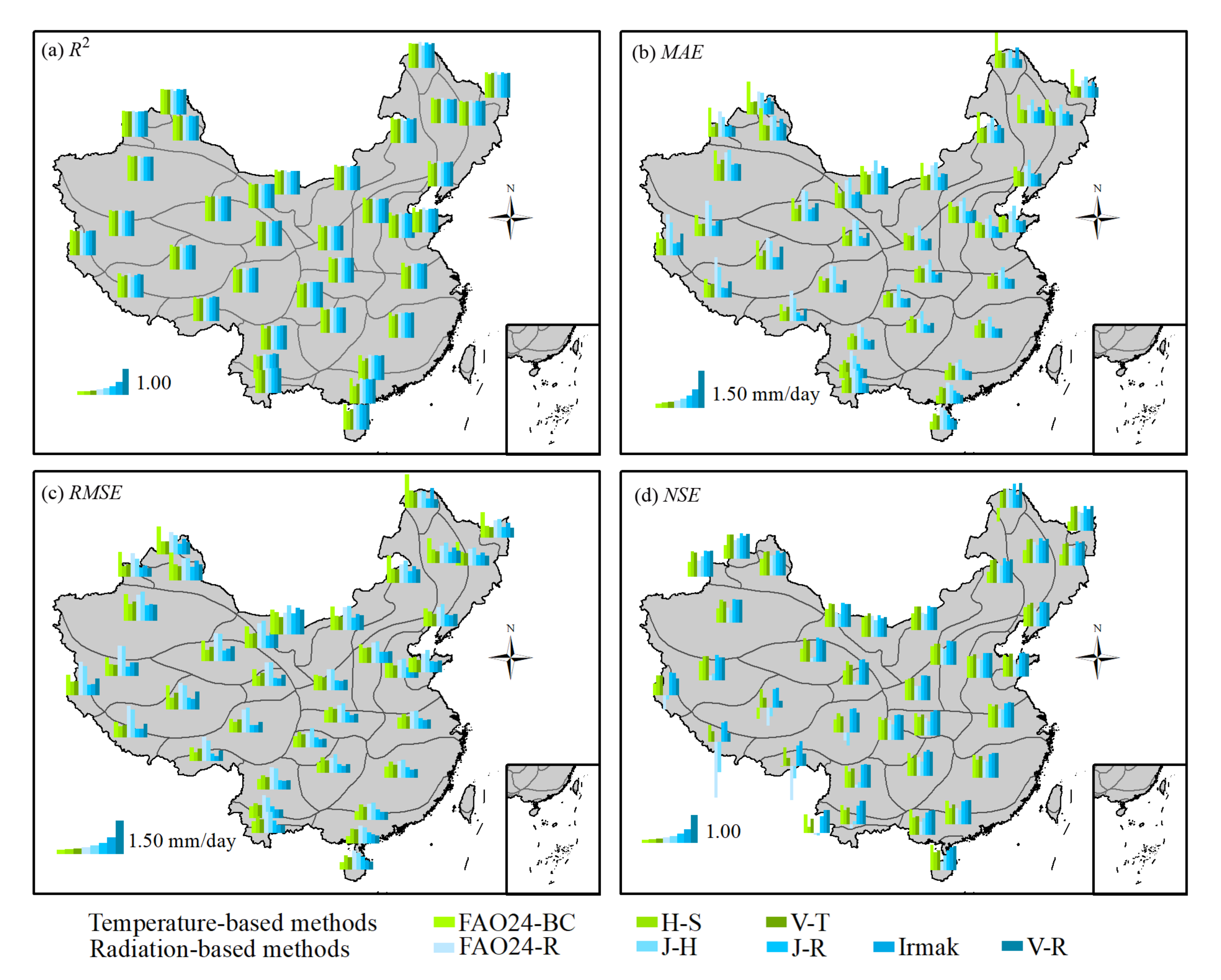
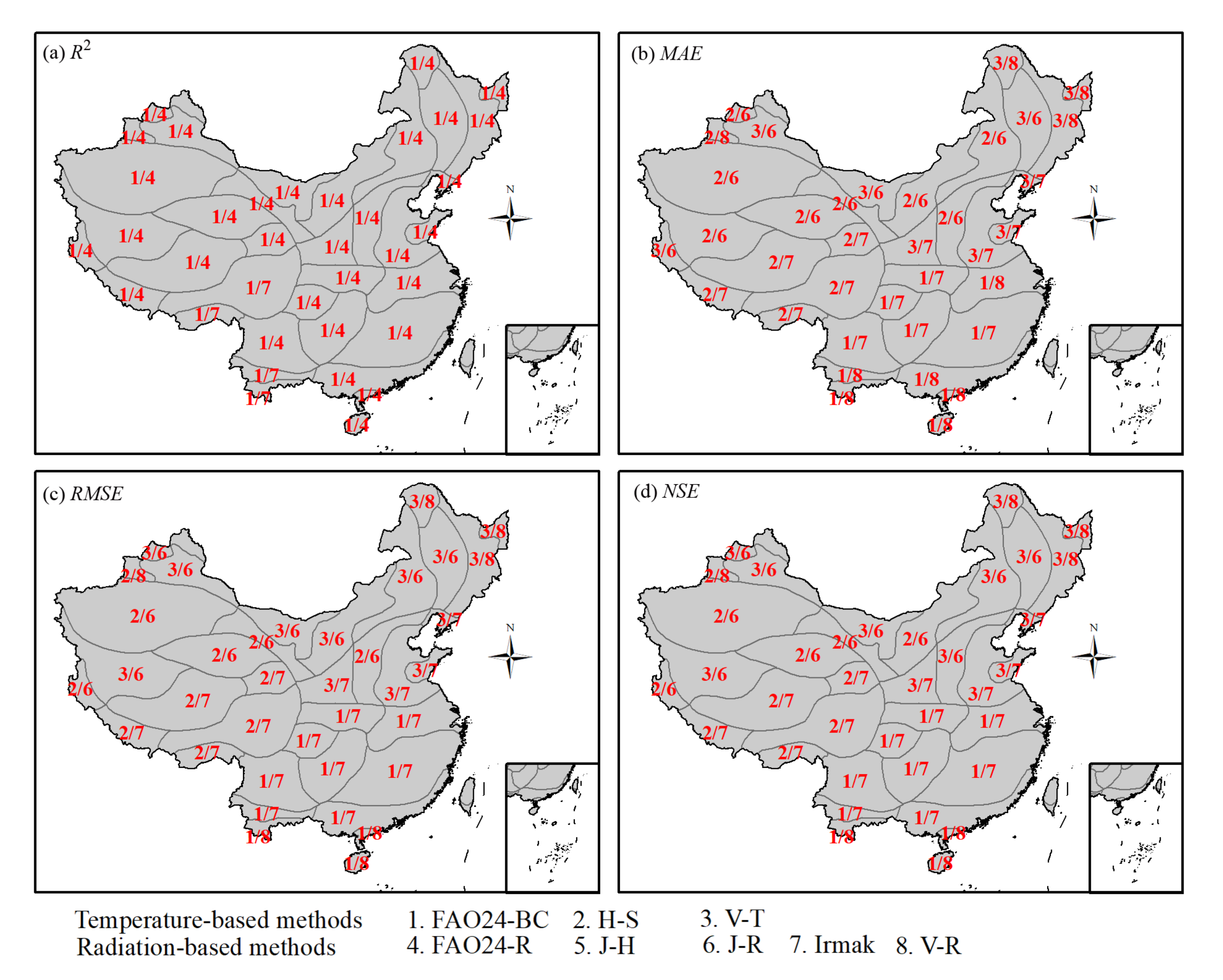
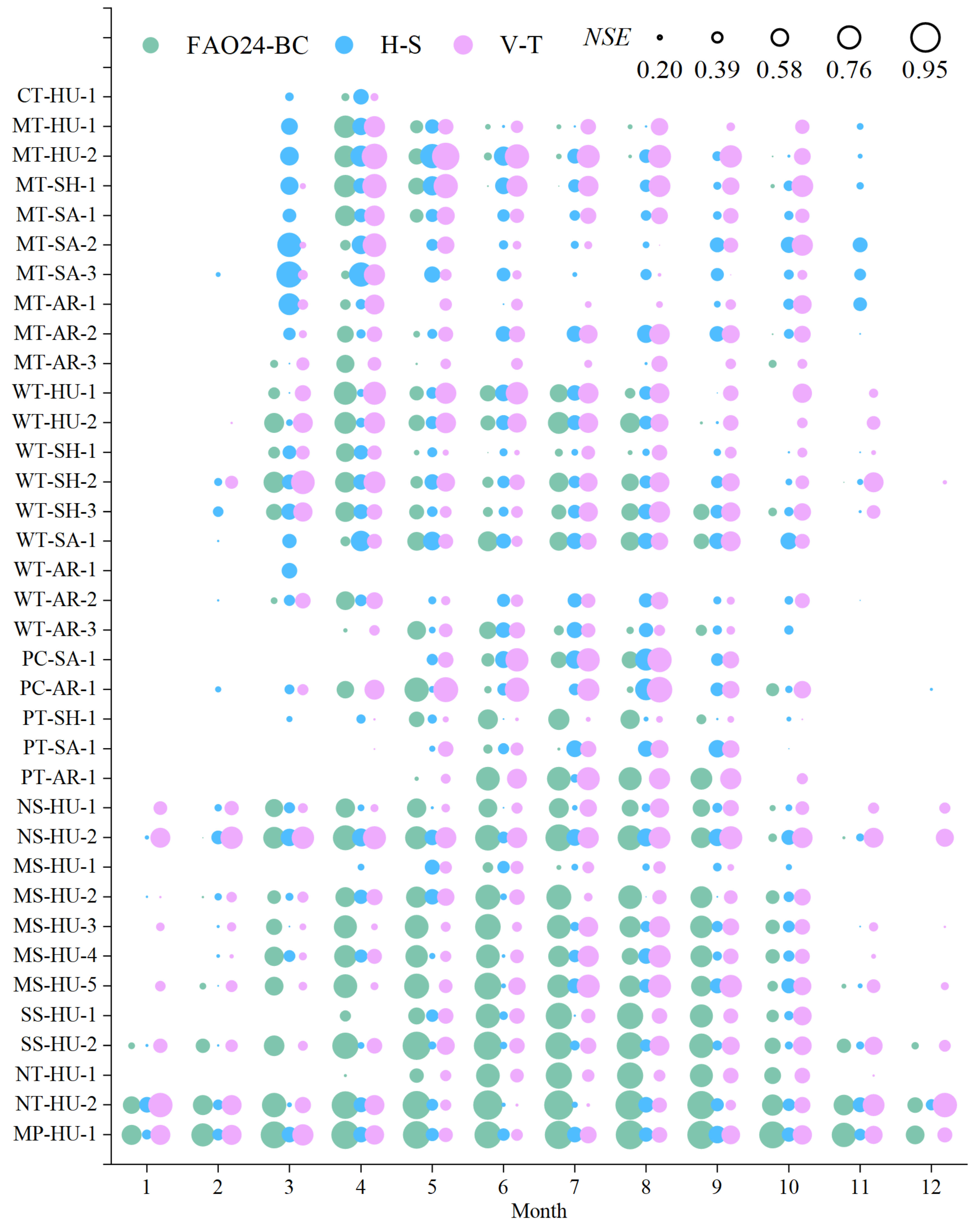
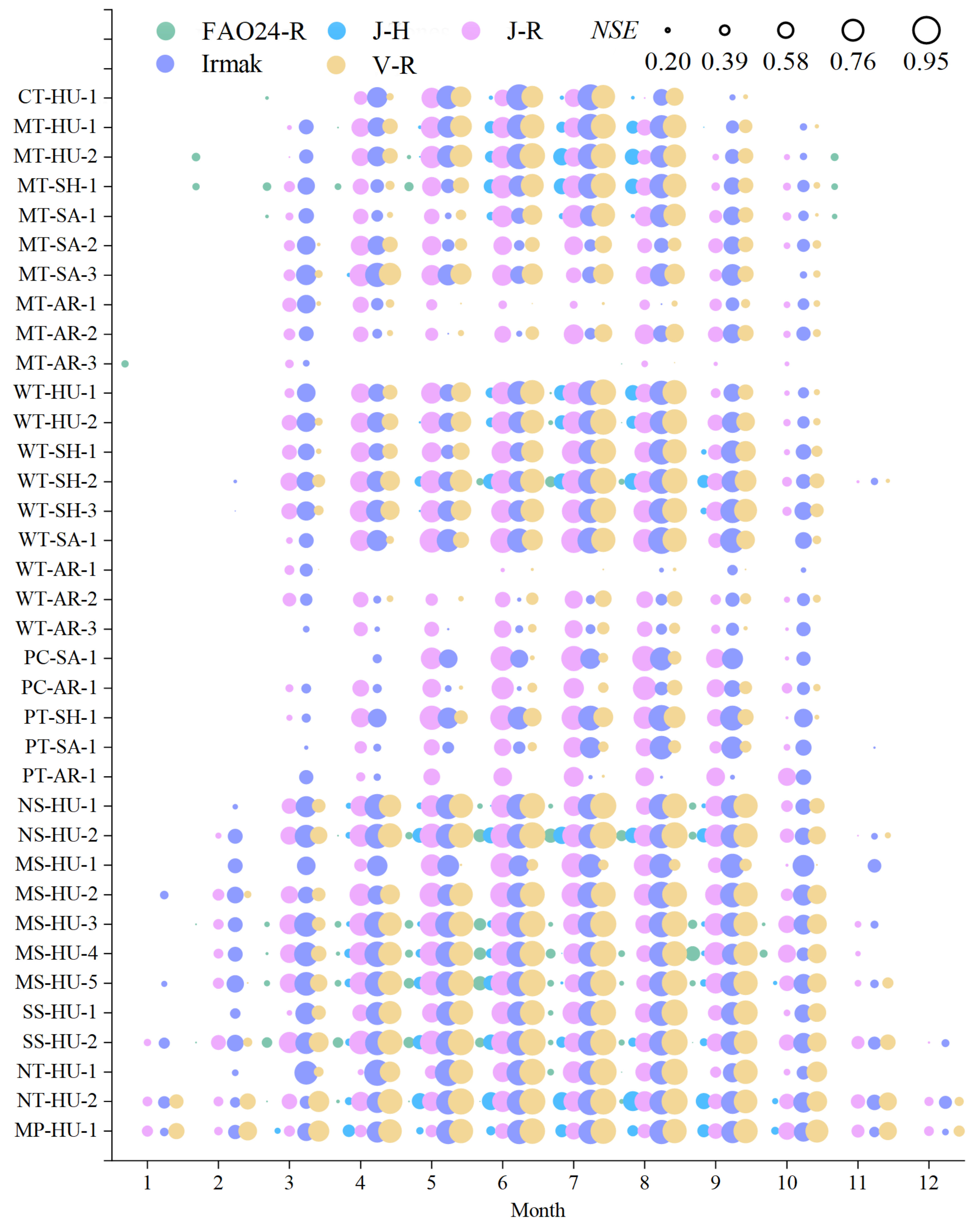

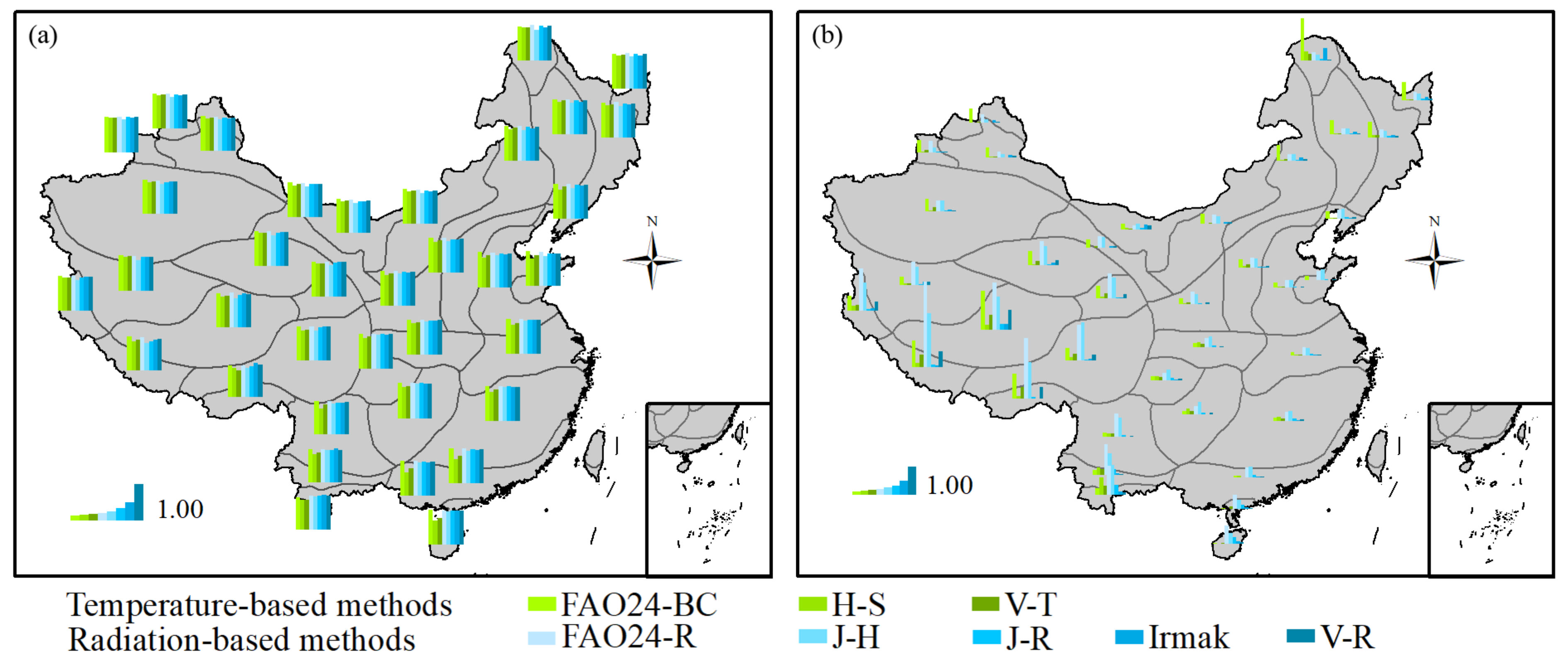

| Temperature Zone | Arid/Humid Region | Code | Location | NMS | Ta (°C) | P (mm) | ET0 (mm) | AI |
|---|---|---|---|---|---|---|---|---|
| Cold temperate zone | Humid | CT-HU-1 | Northern Greater Hinggan Mountains | 5 | −1.8 | 521 | 568 | 0.77 |
| Mid temperate zone | Humid | MT-HU-1 | Lesser Hinggan Mountains–Changbai Mountains | 36 | 4.9 | 694 | 741 | 0.79 |
| Mid temperate zone | Humid | MT-HU-2 | Sanjiang Plain | 4 | 3.8 | 558 | 639 | 0.72 |
| Mid temperate zone | Semi-humid | MT-SH-1 | Songliao Plain | 39 | 5.4 | 567 | 826 | 0.58 |
| Mid temperate zone | Semi-arid | MT-SA-1 | Eastern Inner Mongolia | 26 | 4.2 | 385 | 890 | 0.37 |
| Mid temperate zone | Semi-arid | MT-SA-2 | Northwestern of Northern Xinjiang | 9 | 5.4 | 209 | 865 | 0.21 |
| Mid temperate zone | Semi-arid | MT-SA-3 | Western of Northern Xinjiang | 5 | 6.8 | 263 | 681 | 0.33 |
| Mid temperate zone | Arid | MT-AR-1 | Northern Xinjiang | 15 | 7.1 | 178 | 959 | 0.16 |
| Mid temperate zone | Arid | MT-AR-2 | Central Inner Mongolia | 26 | 7.2 | 242 | 1012 | 0.20 |
| Mid temperate zone | Arid | MT-AR-3 | Western Inner Mongolia | 6 | 8.9 | 73 | 755 | 0.08 |
| Warm temperate zone | Humid | WT-HU-1 | Liaodong Peninsula | 14 | 10.1 | 604 | 872 | 0.58 |
| Warm temperate zone | Humid | WT-HU-2 | Shandong Peninsula | 13 | 13.2 | 701 | 1003 | 0.59 |
| Warm temperate zone | Semi-humid | WT-SH-1 | North China Mountains | 41 | 10.4 | 518 | 973 | 0.45 |
| Warm temperate zone | Semi-humid | WT-SH-2 | North China Plain | 50 | 14.3 | 667 | 986 | 0.58 |
| Warm temperate zone | Semi-humid | WT-SH-3 | Loess Plateau | 34 | 10.8 | 568 | 925 | 0.52 |
| Warm temperate zone | Semi-arid | WT-SA-1 | Qinghai | 11 | 4.9 | 432 | 810 | 0.45 |
| Warm temperate zone | Arid | WT-AR-1 | Southern Xinjiang | 35 | 10.4 | 97 | 1026 | 0.08 |
| Warm temperate zone | Arid | WT-AR-2 | Hexi Corridor | 21 | 8.3 | 171 | 1013 | 0.15 |
| Warm temperate zone | Arid | WT-AR-3 | Qaidam Basin | 13 | 3.5 | 144 | 791 | 0.15 |
| Plateau cold zone | Semi-arid | PC-SA-1 | Southern Qiangtang | 13 | 0.1 | 385 | 734 | 0.44 |
| Plateau cold zone | Arid | PC-AR-1 | Northern Qiangtang | 1 | 5.1 | 71 | 743 | 0.08 |
| Plateau temperate zone | Semi-humid | PT-SH-1 | Western Sichuan–Eastern Tibetan | 38 | 6.1 | 640 | 838 | 0.65 |
| Plateau temperate zone | Semi-arid | PT-SA-1 | Southern flank of Himalayas | 6 | 4.9 | 352 | 899 | 0.33 |
| Plateau temperate zone | Arid | PT-AR-1 | Western Tibetan | 2 | 3.1 | 118 | 1042 | 0.10 |
| North subtropical zone | Humid | NS-HU-1 | Upper and middle Han River | 25 | 15.3 | 910 | 922 | 0.85 |
| North subtropical zone | Humid | NS-HU-2 | Middle and lower reaches of the Yangtze River | 58 | 16.7 | 1278 | 951 | 1.15 |
| Mid subtropical zone | Humid | MS-HU-1 | Southern Tibetan | 3 | 6.4 | 397 | 683 | 0.49 |
| Mid subtropical zone | Humid | MS-HU-2 | Yunnan Plateau | 31 | 15.3 | 890 | 1026 | 0.75 |
| Mid subtropical zone | Humid | MS-HU-3 | Guizhou Plateau | 50 | 16.3 | 1197 | 842 | 1.23 |
| Mid subtropical zone | Humid | MS-HU-4 | Sichuan Basin | 22 | 17.3 | 1081 | 834 | 1.11 |
| Mid subtropical zone | Humid | MS-HU-5 | Jiangnan hilly region | 103 | 18.6 | 1617 | 953 | 1.46 |
| South subtropical zone | Humid | SS-HU-1 | Southern Yunnan Mountain | 8 | 19.5 | 930 | 1020 | 0.79 |
| South subtropical zone | Humid | SS-HU-2 | Fujian and Guangdong hilly region | 46 | 22.1 | 1618 | 1049 | 1.34 |
| South subtropical zone | Humid | SS-HU-3 | Northern Taiwan | 0 | - | - | - | - |
| North tropical zone | Humid | NT-HU-1 | Southern Yunnan valley | 6 | 20.3 | 1409 | 1000 | 1.24 |
| North tropical zone | Humid | NT-HU-2 | Leizhou Peninsula and Northern Hainan | 2 | 23.6 | 1622 | 1193 | 1.17 |
| North tropical zone | Humid | NT-HU-3 | Southern Taiwan | 0 | - | - | - | - |
| Mid tropical zone | Humid | MP-HU-1 | Southern Hainan | 6 | 24.4 | 1816 | 1085 | 1.45 |
| Category | No. | Models | Equation | Reference |
|---|---|---|---|---|
| Temperature-based | 1 | FAO-24 Blaney–Criddle (FAO24-BC) | [43] | |
| 2 | Hargreaves–Samani (H-S) | [44] | ||
| 3 | Valiantzas temperature (V-T) | [45] | ||
| Radiation-based | 4 | FAO24 radiation (FAO24-R) | [43] | |
| 5 | Jensen–Haise (J-H) | [31] | ||
| 6 | Jones–Ritchie (J-R) | [26] | ||
| 7 | Irmak | [46] | ||
| 8 | Valiantzas radiation (V-R) | [47] | ||
| Standard | 9 | FAO56 Penman–Monteith (FAO56-PM) | [9] |
| Zones | Months | |||||||||||
|---|---|---|---|---|---|---|---|---|---|---|---|---|
| 1 | 2 | 3 | 4 | 5 | 6 | 7 | 8 | 9 | 10 | 11 | 12 | |
| CT-HU-1 | 0/0 | 0/0 | 2/4 | 2/7 | 0/7 | 0/7 | 0/7 | 0/8 | 0/7 | 2/0 | 0/0 | 0/0 |
| MT-HU-1 | 0/0 | 0/0 | 2/7 | 1/7 | 1/8 | 3/7 | 3/7 | 3/7 | 3/8 | 3/7 | 2/4 | 0/0 |
| MT-HU-2 | 0/0 | 0/4 | 2/7 | 1/7 | 3/8 | 3/8 | 3/7 | 3/8 | 3/8 | 3/7 | 2/4 | 0/0 |
| MT-SH-1 | 0/0 | 0/4 | 2/7 | 1/6 | 3/6 | 3/8 | 3/7 | 3/7 | 3/7 | 3/7 | 2/4 | 0/0 |
| MT-SA-1 | 0/0 | 0/4 | 2/7 | 1/6 | 1/6 | 3/6 | 3/8 | 3/7 | 3/7 | 3/7 | 0/4 | 0/0 |
| MT-SA-2 | 0/0 | 0/0 | 2/7 | 3/6 | 3/6 | 3/6 | 3/6 | 2/7 | 3/7 | 3/7 | 2/0 | 0/0 |
| MT-SA-3 | 0/0 | 2/0 | 2/7 | 2/7 | 2/8 | 2/8 | 2/8 | 2/7 | 2/7 | 3/7 | 2/0 | 0/0 |
| MT-AR-1 | 0/0 | 0/0 | 2/7 | 3/6 | 3/6 | 3/6 | 3/6 | 3/6 | 3/7 | 3/7 | 2/0 | 0/0 |
| MT-AR-2 | 0/0 | 0/0 | 2/7 | 1/6 | 3/6 | 3/6 | 3/6 | 3/6 | 3/7 | 3/7 | 2/0 | 0/0 |
| MT-AR-3 | 0/4 | 0/0 | 3/6 | 1/0 | 3/0 | 3/0 | 3/0 | 3/6 | 3/6 | 1/6 | 0/0 | 0/0 |
| WT-HU-1 | 0/0 | 0/0 | 3/7 | 1/6 | 3/6 | 1/8 | 1/8 | 3/8 | 3/7 | 3/7 | 3/4 | 0/0 |
| WT-HU-2 | 0/0 | 3/0 | 1/7 | 1/7 | 1/6 | 1/8 | 1/8 | 1/8 | 3/7 | 3/7 | 3/0 | 0/0 |
| WT-SH-1 | 0/0 | 0/0 | 1/7 | 1/6 | 1/6 | 2/8 | 3/8 | 3/7 | 3/7 | 3/7 | 3/0 | 0/0 |
| WT-SH-2 | 0/0 | 3/7 | 1/7 | 1/7 | 3/6 | 3/8 | 1/8 | 1/8 | 3/7 | 3/7 | 3/7 | 3/0 |
| WT-SH-3 | 0/0 | 2/7 | 3/7 | 1/7 | 1/6 | 1/8 | 1/8 | 1/7 | 1/7 | 3/7 | 3/0 | 0/0 |
| WT-SA-1 | 0/0 | 2/0 | 2/7 | 2/7 | 1/6 | 1/6 | 1/7 | 1/7 | 3/7 | 2/7 | 2/0 | 0/0 |
| WT-AR-1 | 0/0 | 0/0 | 2/7 | 0/6 | 0/6 | 0/6 | 0/8 | 0/7 | 0/7 | 0/7 | 2/0 | 0/0 |
| WT-AR-2 | 0/0 | 2/0 | 3/6 | 1/6 | 3/6 | 3/6 | 3/6 | 3/6 | 3/7 | 3/7 | 2/0 | 0/0 |
| WT-AR-3 | 0/0 | 0/0 | 0/7 | 3/6 | 1/6 | 1/6 | 2/6 | 2/6 | 1/7 | 2/7 | 0/0 | 0/0 |
| PC-SA-1 | 0/0 | 0/0 | 0/0 | 0/7 | 3/6 | 3/6 | 3/6 | 3/6 | 3/7 | 0/7 | 0/0 | 0/0 |
| PC-AR-1 | 0/0 | 2/0 | 3/7 | 1/6 | 1/6 | 3/6 | 3/6 | 3/6 | 3/6 | 3/7 | 2/0 | 2/0 |
| PT-SH-1 | 0/0 | 0/0 | 2/7 | 2/7 | 1/6 | 1/6 | 1/7 | 1/7 | 1/7 | 2/7 | 0/0 | 0/0 |
| PT-SA-1 | 0/0 | 0/0 | 0/7 | 3/6 | 3/6 | 1/6 | 3/7 | 3/7 | 3/7 | 2/7 | 0/7 | 0/0 |
| PT-AR-1 | 0/0 | 0/0 | 0/7 | 0/6 | 3/6 | 1/6 | 1/6 | 1/6 | 1/6 | 3/6 | 0/0 | 0/0 |
| NS-HU-1 | 3/0 | 3/7 | 1/7 | 1/7 | 1/7 | 1/7 | 1/8 | 1/7 | 1/8 | 3/7 | 3/7 | 3/0 |
| NS-HU-2 | 3/0 | 3/7 | 1/7 | 1/7 | 1/8 | 1/8 | 1/8 | 1/8 | 1/8 | 3/8 | 3/8 | 3/0 |
| MS-HU-1 | 0/0 | 0/7 | 0/7 | 2/7 | 2/6 | 1/6 | 3/6 | 3/7 | 2/7 | 2/7 | 0/7 | 0/0 |
| MS-HU-2 | 3/7 | 3/7 | 1/7 | 1/6 | 1/6 | 1/8 | 1/7 | 1/7 | 1/7 | 3/7 | 0/0 | 0/0 |
| MS-HU-3 | 3/0 | 3/7 | 1/7 | 1/7 | 1/7 | 1/8 | 1/7 | 1/7 | 1/8 | 1/7 | 3/7 | 3/0 |
| MS-HU-4 | 0/0 | 3/7 | 1/7 | 1/7 | 1/7 | 1/8 | 1/8 | 3/8 | 1/8 | 1/8 | 3/6 | 0/0 |
| MS-HU-5 | 3/7 | 3/7 | 1/7 | 1/7 | 1/8 | 1/8 | 1/8 | 1/8 | 1/8 | 3/7 | 3/8 | 3/0 |
| SS-HU-1 | 0/0 | 0/7 | 0/7 | 1/8 | 1/8 | 1/8 | 1/8 | 1/8 | 1/8 | 3/8 | 0/0 | 0/0 |
| SS-HU-2 | 3/7 | 1/7 | 1/6 | 1/8 | 1/8 | 1/8 | 1/8 | 1/8 | 1/8 | 1/7 | 3/8 | 3/7 |
| NT-HU-1 | 0/0 | 0/7 | 0/7 | 1/7 | 1/7 | 1/8 | 1/8 | 1/8 | 1/8 | 1/8 | 3/0 | 0/0 |
| NT-HU-2 | 3/8 | 1/8 | 1/8 | 1/8 | 1/8 | 1/8 | 1/8 | 1/8 | 1/8 | 1/8 | 1/8 | 3/7 |
| MP-HU-1 | 1/8 | 1/8 | 1/8 | 1/8 | 1/8 | 1/8 | 1/8 | 1/8 | 1/8 | 1/8 | 1/8 | 1/8 |
| Zones | Methods | |||||||
|---|---|---|---|---|---|---|---|---|
| 1 | 2 | 3 | 4 | 5 | 6 | 7 | 8 | |
| CT-HU-1 | 0.46/1.11 | 0.66/0.30 | 0.68/0.35 | 0.69/0.17 | 0.77/0.75 | 0.81/0.18 | 0.64/0.90 | 0.84/0.33 |
| MT-HU-1 | 0.58/1.03 | 0.79/0.27 | 0.78/0.41 | 0.71/0.21 | 0.79/0.95 | 0.82/0.31 | 0.80/0.62 | 0.85/0.48 |
| MT-HU-2 | 0.56/1.07 | 0.86/0.26 | 0.86/0.35 | 0.71/0.19 | 0.87/0.90 | 0.82/0.30 | 0.76/0.70 | 0.86/0.43 |
| MT-SH-1 | 0.59/1.06 | 0.89/0.27 | 0.85/0.39 | 0.74/0.21 | 0.85/1.00 | 0.88/0.32 | 0.86/0.67 | 0.91/0.49 |
| MT-SA-1 | 0.59/1.16 | 0.87/0.40 | 0.80/0.53 | 0.74/0.20 | 0.77/1.13 | 0.92/0.36 | 0.90/0.72 | 0.93/0.58 |
| MT-SA-2 | 0.60/0.94 | 0.98/0.17 | 0.85/0.34 | 0.73/0.15 | 0.81/0.88 | 0.95/0.19 | 0.95/0.64 | 0.98/0.41 |
| MT-SA-3 | 0.62/0.82 | 0.93/0.04 | 0.81/0.32 | 0.70/0.09 | 0.73/0.78 | 0.90/0.11 | 0.93/0.42 | 0.92/0.35 |
| MT-AR-1 | 0.64/0.95 | 1.06/0.19 | 0.90/0.35 | 0.76/0.14 | 0.81/0.99 | 1.00/0.24 | 1.03/0.64 | 1.04/0.44 |
| MT-AR-2 | 0.64/1.09 | 0.96/0.34 | 0.83/0.55 | 0.74/0.15 | 0.70/1.25 | 0.97/0.30 | 1.04/0.45 | 0.96/0.62 |
| MT-AR-3 | 0.68/1.18 | 1.10/0.44 | 0.91/0.65 | 0.81/0.17 | 0.74/1.55 | 1.09/0.41 | 1.24/0.44 | 1.09/0.77 |
| WT-HU-1 | 0.66/0.89 | 0.92/0.33 | 0.89/0.43 | 0.72/0.28 | 0.83/1.22 | 0.83/0.40 | 0.92/0.35 | 0.86/0.63 |
| WT-HU-2 | 0.72/0.72 | 0.93/0.35 | 0.96/0.19 | 0.72/0.31 | 0.8/1.29 | 0.86/0.31 | 0.98/0.15 | 0.88/0.59 |
| WT-SH-1 | 0.66/0.87 | 0.83/0.30 | 0.78/0.43 | 0.71/0.28 | 0.67/1.21 | 0.88/0.30 | 0.98/0.32 | 0.88/0.60 |
| WT-SH-2 | 0.72/0.66 | 0.89/0.17 | 0.90/0.10 | 0.73/0.30 | 0.74/1.18 | 0.89/0.21 | 1.01/0.08 | 0.89/0.47 |
| WT-SH-3 | 0.69/0.81 | 0.87/0.21 | 0.83/0.30 | 0.69/0.28 | 0.65/1.19 | 0.87/0.26 | 0.99/0.18 | 0.87/0.58 |
| WT-SA-1 | 0.66/1.07 | 0.84/0.29 | 0.71/0.66 | 0.65/0.16 | 0.54/1.20 | 0.85/0.29 | 0.92/0.38 | 0.85/0.71 |
| WT-AR-1 | 0.64/0.83 | 0.93/0.21 | 0.80/0.38 | 0.74/0.13 | 0.64/1.17 | 0.93/0.27 | 1.07/0.29 | 0.96/0.49 |
| WT-AR-2 | 0.65/1.03 | 0.95/0.33 | 0.80/0.62 | 0.72/0.15 | 0.62/1.35 | 0.96/0.29 | 1.08/0.33 | 0.94/0.68 |
| WT-AR-3 | 0.64/1.27 | 0.92/0.43 | 0.74/0.81 | 0.66/0.13 | 0.55/1.37 | 0.90/0.43 | 0.99/0.49 | 0.91/0.83 |
| PC-SA-1 | 0.64/1.54 | 0.86/0.68 | 0.69/1.15 | 0.60/0.21 | 0.50/1.46 | 0.75/0.83 | 0.86/0.71 | 0.83/1.13 |
| PC-AR-1 | 0.67/1.13 | 1.04/0.26 | 0.83/0.62 | 0.66/0.11 | 0.54/1.33 | 0.94/0.37 | 1.02/0.49 | 0.97/0.66 |
| PT-SH-1 | 0.71/1.03 | 0.79/0.37 | 0.70/0.64 | 0.64/0.20 | 0.47/1.31 | 0.85/0.28 | 0.94/0.35 | 0.86/0.71 |
| PT-SA-1 | 0.70/1.29 | 0.86/0.66 | 0.73/0.98 | 0.61/0.15 | 0.48/1.61 | 0.80/0.53 | 0.95/0.4 | 0.82/0.97 |
| PT-AR-1 | 0.66/1.51 | 1.02/0.59 | 0.79/1.06 | 0.64/0.07 | 0.48/1.60 | 0.86/0.71 | 1.02/0.45 | 0.91/1.05 |
| NS-HU-1 | 0.72/0.63 | 0.81/0.09 | 0.86/−0.04 | 0.69/0.39 | 0.62/1.13 | 0.83/0.24 | 0.98/0.01 | 0.84/0.51 |
| NS-HU-2 | 0.77/0.56 | 0.93/−0.02 | 1.01/−0.19 | 0.73/0.31 | 0.73/1.14 | 0.86/0.16 | 1.04/−0.20 | 0.87/0.42 |
| MS-HU-1 | 0.71/1.06 | 0.84/0.35 | 0.71/0.72 | 0.64/0.12 | 0.55/1.28 | 0.84/0.26 | 0.97/0.17 | 0.84/0.74 |
| MS-HU-2 | 0.78/0.62 | 0.9/−0.04 | 0.91/−0.10 | 0.67/0.32 | 0.56/1.23 | 0.91/0.07 | 1.13/−0.40 | 0.91/0.37 |
| MS-HU-3 | 0.74/0.68 | 0.81/0.04 | 0.88/−0.12 | 0.69/0.43 | 0.61/1.10 | 0.82/0.25 | 0.97/−0.04 | 0.81/0.58 |
| MS-HU-4 | 0.75/0.61 | 0.85/−0.03 | 0.91/−0.16 | 0.71/0.41 | 0.65/1.10 | 0.83/0.25 | 1.04/−0.22 | 0.85/0.50 |
| MS-HU-5 | 0.75/0.62 | 0.88/−0.08 | 0.98/−0.31 | 0.71/0.39 | 0.65/1.14 | 0.82/0.23 | 1.04/−0.28 | 0.84/0.46 |
| SS-HU-1 | 0.75/0.58 | 0.93/−0.26 | 0.91/−0.13 | 0.67/0.39 | 0.56/1.20 | 0.86/0.09 | 1.20/−0.88 | 0.90/0.23 |
| SS-HU-2 | 0.79/0.63 | 0.93/0.01 | 1.14/−0.61 | 0.69/0.56 | 0.65/1.33 | 0.80/0.42 | 1.05/−0.37 | 0.84/0.53 |
| NT-HU-1 | 0.73/0.65 | 0.86/−0.20 | 0.86/−0.02 | 0.66/0.43 | 0.54/1.14 | 0.82/0.11 | 1.15/−0.88 | 0.84/0.29 |
| NT-HU-2 | 0.84/0.55 | 1.05/−0.13 | 1.33/−0.81 | 0.69/0.55 | 0.70/1.34 | 0.79/0.41 | 1.07/−0.51 | 0.85/0.45 |
| MP-HU-1 | 0.85/0.52 | 0.98/−0.03 | 1.21/−0.56 | 0.68/0.55 | 0.65/1.31 | 0.77/0.41 | 1.12/−0.75 | 0.84/0.41 |
Publisher’s Note: MDPI stays neutral with regard to jurisdictional claims in published maps and institutional affiliations. |
© 2021 by the authors. Licensee MDPI, Basel, Switzerland. This article is an open access article distributed under the terms and conditions of the Creative Commons Attribution (CC BY) license (https://creativecommons.org/licenses/by/4.0/).
Share and Cite
Yang, Y.; Chen, R.; Han, C.; Liu, Z.; Wang, X. Optimal Selection of Empirical Reference Evapotranspiration Method in 36 Different Agricultural Zones of China. Agronomy 2022, 12, 31. https://doi.org/10.3390/agronomy12010031
Yang Y, Chen R, Han C, Liu Z, Wang X. Optimal Selection of Empirical Reference Evapotranspiration Method in 36 Different Agricultural Zones of China. Agronomy. 2022; 12(1):31. https://doi.org/10.3390/agronomy12010031
Chicago/Turabian StyleYang, Yong, Rensheng Chen, Chuntan Han, Zhangwen Liu, and Xiqiang Wang. 2022. "Optimal Selection of Empirical Reference Evapotranspiration Method in 36 Different Agricultural Zones of China" Agronomy 12, no. 1: 31. https://doi.org/10.3390/agronomy12010031
APA StyleYang, Y., Chen, R., Han, C., Liu, Z., & Wang, X. (2022). Optimal Selection of Empirical Reference Evapotranspiration Method in 36 Different Agricultural Zones of China. Agronomy, 12(1), 31. https://doi.org/10.3390/agronomy12010031







